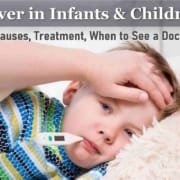Nausea and vomiting in Infants and Children
Nausea and vomiting are common in children, and are usually part of a mild, short-lived illness, frequently caused by a viral infection. While many children naturally overcome nausea and vomiting without any treatment, it’s crucial to recognize when it’s necessary to seek assistance if the child’s condition doesn’t improve.
Why does vomiting occur?
Vomiting occurs when nerves in the body or brain detect a trigger, such as food poisoning, specific infections or medications, or motion. Nausea sometimes, but not always, precedes vomiting. Younger children may not be able to describe nausea, though they may express discomfort through stomach aches or other general complaints.
Vomiting often has a benefit since it provides a way for the body to get rid of potentially harmful substances.However, medicines and methods for inducing vomiting (e.g., syrup of ipecac, inserting a finger into the throat) are no longer recommended, even if an infant or child has ingested a harmful substance. In such cases, it is best to promptly call for emergency medical assistance.
Vomit versus spit up
There is a distinction between vomiting and spitting up, although they are frequently used interchangeably. Spitting up typically happens with a burp after feeding. The medical term for this is gastroesophageal reflux (GER). Most infants expel milk or formula through the mouth or nose during spitting up.
Causes of vomiting
Vomiting can be caused by a number of different problems. The possible causes of vomiting depend upon a child’s age.
Newborns and young infants
- It can be challenging to discern whether an infant is spitting up or vomiting because some infants experience reflux forcefully or in significant amounts. Your child’s doctor or nurse can assist in identifying the cause and determining if treatment is necessary.
- Forceful vomiting in newborns can indicate a serious condition and always requires further evaluation. Potential causes of vomiting in newborns and young infants include a blockage or narrowing of the stomach (pyloric stenosis) or a blockage of the intestines (intestinal obstruction).
- Infants can also vomit because of infections of the intestine or other parts of the body. Any young infant (newborn to 3 months) who develops a temperature of 100.4º F (38º C) or higher, with or without vomiting, should see a doctor or nurse.
Older infants and children
- Most common cause of vomiting in older infants and children is infectious gastroenteritis, an infection affecting the stomach or intestines, typically caused by a virus. Vomiting triggered by gastroenteritis usually starts suddenly and resolves swiftly, often within 24 hours. Additional symptoms of gastroenteritis may include nausea, diarrhea, fever, or abdominal pain.
- Gastroenteritis can develop following the ingestion of contaminated food or contact with a contaminated object (or hand) that is then put into the mouth. The viruses responsible for gastroenteritis are easily transmitted. Diligent hygiene practices, particularly handwashing, can prevent the spread of these infections.
- Less frequently, vomiting occurs after consuming improperly stored or prepared foods containing bacteria or toxins; this is known as food poisoning.
- Other illnesses can also cause vomiting in older infants and children, including gastroesophageal reflux, peptic ulcer disease, an intestinal blockage (obstruction), and others.
Adolescents
- Similar to children, the most common cause of nausea and vomiting in adolescents is infectious gastroenteritis. Vomiting usually resolves within 24 to 48 hours in an adolescent with gastroenteritis.
- Less common causes of vomiting in adolescents include appendicitis (inflammation of the appendix), induced vomiting (eg, as seen with bulimia), pregnancy, gastric ulcers (of the stomach), pancreatitis (inflammation of the pancreas), inflammatory bowel disease (eg, Crohn’s disease), and consumption of toxic substances (eg, overdose).
Nausea and vomiting diagnosis
Most children with vomiting do not need to be seen by a healthcare provider. However, you should monitor for signs that the child is getting worse or not getting better within 24 hours. If your child has severe pain or has signs of dehydration, they should be seen sooner. If you are concerned about your child, call the child’s doctor or nurse. If the child sees a doctor or nurse, he or she will review the child’s medical history, perform an exam, and if needed, perform testing.
Home care of nausea and vomiting
The following are some simple recommendations to help care for children with nausea and vomiting at home.
Monitor for dehydration
Dehydration can develop in children with vomiting. Signs of mild dehydration include
- A slightly dry mouth
- Thirst
Children who are mildly dehydrated do not need immediate medical attention but should be monitored for signs of worsening dehydration.
Signs of moderate or severe dehydration include:
- Decreased urination (not going to the bathroom or no wet diaper in 6 hours)
- A lack of tears when crying
- A dry mouth
- Sunken eyes
A child who is moderately or severely dehydrated should be evaluated by a doctor or nurse as soon as possible.
Dietary recommendations
Children who are vomiting but are not dehydrated can continue to eat a regular diet as tolerated. Dehydrated children require rehydration (replacement of lost fluid).
Infants
- If a breastfeeding infant vomits, they should continue to breastfeed unless advised otherwise by your doctor or nurse. Oral rehydration are not usually needed for infants who exclusively breastfeed because breastmilk is more easily digested. If your infant vomits immediately after nursing, you can try to breastfeed more frequently and for a shorter time.
- For example, breastfeed every 30 minutes for five to 10 minutes. If vomiting improves within two to three hours, you can resume the usual feeding schedule. If vomiting worsens or does not improve within 24 hours, call your child’s doctor or nurse (see ‘When to seek help’ below).
- If your infant drinks formula, initially offer one to two ounces of an oral rehydration solution (eg, Pedialyte®) every 30 minutes for two to three hours. If vomiting improves, resume feeding with full strength infant formula. If vomiting worsens or does not improve within 24 hours, call your child’s doctor or nurse (see ‘When to seek help’ below).
Older infants and children
- Older infants and children who vomit can continue to eat if they feel up to it. However, it’s typical for children to experience reduced appetite during a vomiting illness.
- Keep an eye out for signs of dehydration and avoid forcing the child to eat, particularly within the first 24 hours.. Encourage the child to drink fluids. The best fluids are the commercially prepared oral rehydration solutions (see ‘Oral rehydration therapy’ below). Other fluids, including water, diluted juice, or soda can be given in small quantities.
- Apple, pear, and cherry juice, and other beverages with high sugar content, should be avoided. Sports drinks (eg, Gatorade) should also be avoided since they have too much sugar and have inappropriate electrolyte levels.
Recommended foods include a combination of complex carbohydrates (rice, wheat, potatoes, bread), lean meats, yogurt, fruits, and vegetables. High fat foods are more difficult to digest, and should be avoided. - There’s no need to limit a child’s diet to clear liquids or the BRAT diet (bananas, rice, applesauce, toast). While these foods are sometimes suggested to alleviate diarrhea, they don’t provide sufficient nutrients for a child.
Oral rehydration therapy
- Oral rehydration therapy (ORT) was developed as a safer, less-expensive, and easier alternative to intravenous (IV) fluids. Oral rehydration solution (ORS) is a liquid solution that contains glucose (a sugar) and electrolytes (sodium, potassium, chloride), which are lost with vomiting and diarrhea.
- ORS doesn’t cure vomiting, but it does aid in preventing and treating dehydration, which can arise due to a vomiting illness. You can buy ORS at most grocery stores and pharmacies in the United States without a prescription. A few widely available brands include Pedialyte®, Infalyte®, and ReVital®, although generic brands work equally well (table 1). Gelatin, tea, fruit juice, rice water, and other beverages are not recommended for children who are dehydrated. Do not try to prepare ORS recipes at home because the formulas must be exact.
- You can administer ORS at home if your child is experiencing mild dehydration, refusing to consume a normal diet, or is dealing with vomiting, diarrhea, or both. If necessary, you can provide ORS in frequent, small sips or small amounts via spoon, bottle, or cup over a span of three to four hours. Your child’s doctor or nurse might provide specific instructions for administering oral rehydration. One method is described below:
- The recommended amount is 5 teaspoons per pound, or 50 milliliters per kilogram. For a 20-pound (9 kg) child, this would equal 100 teaspoons (450 milliliters).
- Measure the solution with a standardized medicine syringe or measuring cup or spoon, rather than a regular cup or spoon.
- Give the fluid by teaspoonfuls (5 milliliters each) every one to two minutes or as tolerated.
After you give the whole amount, the child can eat a normal diet.
- Children who refuse to drink or who vomit immediately after drinking ORS should be monitored closely for worsening dehydration. Children who are not dehydrated can continue to drink ORS between episodes of vomiting to prevent dehydration. (See ‘Monitor for dehydration’ above.)
Medicines
Medicines to reduce nausea and vomiting, called antiemetics, might be recommended in certain situations (to reduce the risk of dehydration in children who vomit repeatedly or to prevent motion sickness). These medicines require a prescription, and you should not give them to an infant or child unless your child’s doctor or nurse has recommended them. Non-prescription treatments for nausea or vomiting are not recommended for infants or children.
Preventing spread
If your child is vomiting, you need to be careful to avoid spreading the infection to yourself, your family, and friends. Wash your hands frequently and keep sick children out of school or daycare. Children who have vomited two or more times within a 24-hour period due to a contagious condition should be kept out of school or daycare until they have not vomited for 24 hours.
Hygiene measures
Hand washing is essential and highly effective in preventing the spread of infection. Wet your hands with water and plain or antimicrobial soap, and rub them together for 15 to 30 seconds. Pay special attention to the fingernails, between the fingers, and the wrists. Rinse your hand thoroughly, dry them with a paper towel, and throw away the paper towel.
Alcohol-based hand rubs serve as a suitable alternative for disinfecting hands when a sink is not available. Spread the hand rub over the entire surface of your hands, fingers, and wrists until dry. You can use the rub over and over, if needed. Hand rubs are available as a liquid or wipe in small, portable sizes that are easy to carry in a pocket or handbag. If you hands are visibly dirty, you should wash them with soap and water.
When to seek help?
You should call your doctor or nurse immediately if your child has any of the following:
- Bile (green) or blood-tinged (red or brown) vomit.
- Any episode of vomiting in a newborn, or vomiting that continues for more than 24 hours in an infant or child.
- If an infant refuses to eat or drink anything for more than a few hours.
- Moderate to severe dehydration (dry mouth, no tears when crying, not urinating or having a wet diaper in six hours).
- Abdominal pain that is severe, even if it comes and goes.
- Fever higher than 102ºF (39ºC) once or fever higher than 101ºF (38.4ºC) for more than three days.
- Behavior changes, including lethargy or decreased responsiveness.










